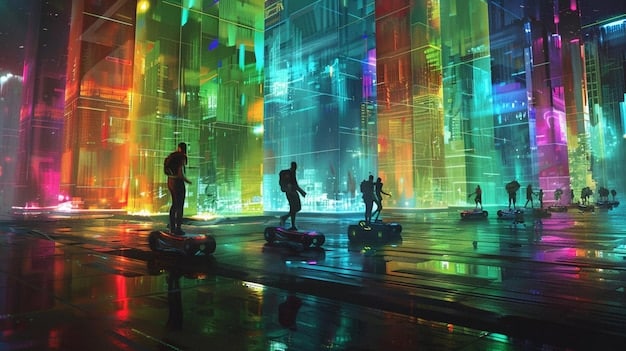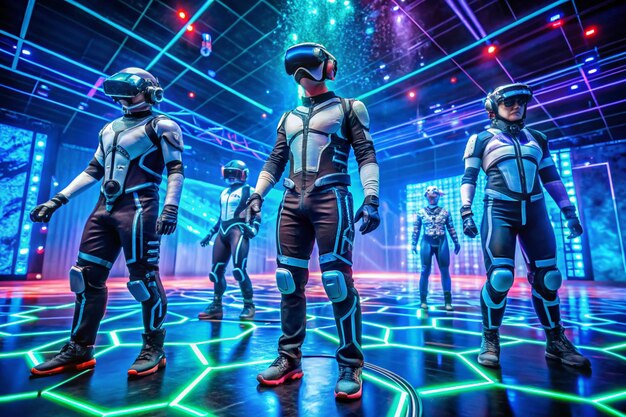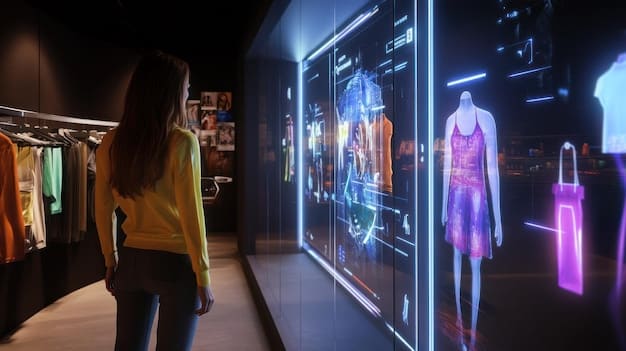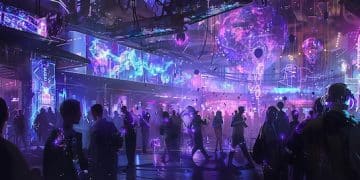How the Metaverse is Changing Entertainment by 2025

By 2025, the metaverse is fundamentally reshaping how people consume entertainment, offering immersive, interactive experiences that transcend traditional boundaries, from virtual concerts and interactive storytelling to entirely new forms of social gaming and digital art showcases.
The dawn of 2025 beckons a transformative era for how we engage with digital content, particularly as we witness how the metaverse is changing the way we consume entertainment in 2025. This evolving digital frontier promises not just consumption but deep immersion and participation, fundamentally redefining our relationship with pop culture. Gone are the days when entertainment was a passive experience; the metaverse is crafting a dynamic landscape where audiences are active co-creators and participants.
The evolution of virtual concerts and live events
The concept of a virtual concert has moved far beyond simple live streams. In 2025, metaverse platforms are hosting elaborate, multi-sensory experiences that replicate and even enhance the energy of physical gatherings. Artists are leveraging this technology to create bespoke digital venues, interact with fans’ avatars in real-time, and incorporate fantastical elements impossible in the physical world. This shift is not merely about convenience; it’s about unlocking new creative dimensions for performers and unparalleled access for audiences, regardless of geographical limitations.
Virtual concerts are now leveraging advanced haptic feedback systems, allowing users to “feel” the bass or vibrations of the crowd, deepening the sense of presence. The visual fidelity has also dramatically improved, with photorealistic avatars and dynamic environments that respond to the music and audience engagement. This technological leap enables artists to perform multiple sets in various virtual locations simultaneously or even create interactive narratives within their performances.
Beyond the stage: immersive fan engagement
These virtual spaces foster uniquely intimate fan interactions. Imagine having a digital meet-and-greet with your favorite artist’s avatar before they step onto a colossal virtual stage floating amidst nebulae. This level of personalized access builds stronger communities and transforms the fan-artist relationship.
- Avatar Customization: Fans express individuality through unique digital identities.
- Interactive Environments: Virtual spaces adapt to audience actions and preferences.
- Real-time Interaction: Direct communication with artists’ avatars and fellow concert-goers.
- Exclusive Digital Merchandise: Limited-edition NFTs and virtual wearables enhance the experience.
The economic models supporting these events are also innovating. Beyond ticket sales, artists and platforms are exploring digital merchandise, exclusive NFT drops tied to specific performances, and subscription models that grant access to a season of virtual shows. This burgeoning economy creates new revenue streams for creators and unique ownership opportunities for fans, blurring the lines between consumer and collector. The metaverse venue itself can be reconfigured for each event, offering endless possibilities for creative expression and unique branding opportunities.
Interactive storytelling and cinematic experiences
Traditional filmmaking is undergoing a profound transformation within the metaverse. By 2025, cinematic experiences are evolving into deeply interactive narratives where viewers aren’t just observers but active participants shaping the plot. Imagine stepping into a film as a character, making choices that influence the storyline, or exploring detailed worlds at your own pace. This elevates storytelling from passive viewing to an active, often collaborative, adventure.
These immersive films blend elements of gaming, theater, and traditional cinema, offering unprecedented levels of agency. Viewers might solve puzzles, converse with AI-powered characters, or embark on branching narratives that offer different outcomes upon repeat viewings. The depth of engagement is unparalleled, creating a more memorable and personal connection to the story. This shift demands new forms of narrative design and technological infrastructure to support complex decision trees and real-time rendering.
New narrative paradigms for metaverse films
The metaverse enables narrative structures that break free from linear constraints. Directors can design sprawling, open-ended experiences where every decision or interaction has tangible consequences within the story world. This opens up entirely new avenues for artistic expression and audience engagement that were previously confined to niche gaming genres.
- Branching Narratives: Multiple plotlines unfold based on viewer choices.
- Environmental Storytelling: Clues and backstory are embedded within the interactive world.
- Player as Protagonist: Viewers become “characters” within the unfolding drama.
- Multiplayer Experiences: Collaborative storytelling where groups influence the narrative.
The development of these interactive cinematic experiences often involves complex AI, advanced character animation, and spatial audio to create a truly believable and responsive environment. Production studios are investing heavily in new tools and talent capable of conceptualizing and executing these multi-layered narratives. This represents a significant deviation from traditional film production workflows, emphasizing iterative design and collaborative development.
Social gaming and competitive esports in virtual worlds
The metaverse is the ultimate playground for social gaming and competitive esports, offering an unparalleled level of immersion and community. By 2025, gaming within these virtual worlds is less about staring at a screen and more about physically embodying an avatar within a shared digital space. This fosters a deeper sense of presence and camaraderie, transforming casual play into a communal experience.
Esports, too, is finding new dimensions in the metaverse. Spectators can “attend” major tournaments as avatars, experiencing the tension and excitement from within the virtual stadium. Beyond passive viewing, some platforms allow fans to participate in real-time predictions, interact with fellow spectators, and even influence certain in-game events, blurring the lines between audience and participant. This enhanced interactivity could revolutionize fan engagement in competitive gaming.
Enhanced social interaction in metaverse games
The social aspect of metaverse gaming is key to its appeal. Players can naturally converse, collaborate, and compete as if they were in the same physical room. This organic interaction significantly elevates the gaming experience, turning every session into a unique social gathering.

Metaverse games often integrate social hubs, user-generated content, and customizable personal spaces, encouraging players to spend more time within these worlds. The ability to express oneself through unique avatars and digital possessions further strengthens community bonds and creates a vibrant, interconnected ecosystem. Developers are also experimenting with blockchain technology to enable true ownership of in-game assets, enhancing player investment and generating new economic opportunities.
The integration of advanced communication technologies, such as spatial audio and realistic haptic feedback, makes interactions feel more genuine. Players can gather in virtual cafes, explore fantastical landscapes together, or simply hang out in their personalized digital homes. This focus on shared experiences and persistent virtual environments distinguishes metaverse gaming from traditional online multiplayer titles, fostering a sense of belonging and ongoing engagement.
The rise of digital art and collectibles (NFTs)
The metaverse has catalyzed an unprecedented surge in digital art and collectibles, primarily driven by the proliferation of Non-Fungible Tokens (NFTs). In 2025, NFTs are not just speculative assets but integral components of digital identity and social status within virtual worlds. Owning a unique piece of digital art or a limited-edition virtual garment allows individuals to express themselves and signal their belonging to specific communities.
Virtual galleries and museums are becoming prominent venues for showcasing these digital masterpieces. Artists can create immersive installations that defy physical limitations, allowing viewers to step inside a painting or experience a sculpture from every conceivable angle. This democratizes access to art, breaking down geographical barriers and opening up new avenues for creative expression and monetisation for artists globally.
Impact on artists and creative economies
NFTs provide artists with direct pathways to monetise their work, bypassing traditional intermediaries. This empowers creators and allows them to connect directly with collectors, fostering a more equitable and transparent creative economy. Furthermore, programmable NFTs can offer royalties on secondary sales, ensuring artists continue to benefit from their creations.
The technology behind NFTs, primarily blockchain, ensures the verifiable scarcity and authenticity of digital assets, lending them value akin to physical collectibles. This newfound ability to prove ownership of digital items has unlocked entirely new markets for art, virtual fashion, in-game assets, and even virtual real estate. The metaverse provides the context and utility for these digital possessions, making them more than just static images but interactive elements of a dynamic digital life.
The concept of fractional ownership of NFTs is also gaining traction, allowing multiple individuals to co-own high-value digital assets. This further democratizes access to expensive art and opens up new investment opportunities. The metaverse is quickly becoming a canvas for digital expression, where creativity is not limited by physical constraints, and authenticity is guaranteed by decentralized ledgers.
Education and skill-building through immersive platforms
Beyond pure entertainment, the metaverse is proving to be a powerful tool for education and skill-building in 2025. Immersive platforms offer experiential learning opportunities that far surpass traditional methods. Imagine exploring ancient Rome from within, conducting complex scientific experiments in a virtual lab, or practicing surgical procedures in a simulated operating room – all without physical risk or resource constraints.
This approach transforms learning from a passive intake of information into an active, hands-on discovery. Students can interact with historical figures, dissect virtual organisms, or collaborate with peers on projects in shared 3D environments, deepening their understanding and retention of complex concepts. The gamified nature of many metaverse educational experiences also increases engagement and motivation, making learning more enjoyable and effective.
Practical applications in professional training
The applications extend to professional training and development. High-risk professions, like medicine, aviation, or engineering, can utilize metaverse simulations for realistic training scenarios. This allows professionals to hone their skills in a safe, controlled environment, reducing errors and improving competency before engaging in real-world applications.
- Virtual Field Trips: Explore remote locations or historical sites.
- Simulated Labs: Conduct experiments without needing physical equipment.
- Role-Playing Scenarios: Practice communication and problem-solving skills.
- Collaborative Workspaces: Team projects in shared 3D environments.
The scalability of metaverse-based education is also a significant advantage. A single virtual classroom can host students from anywhere in the world, breaking down geographical barriers to quality education. Furthermore, the ability to personalize learning paths and adapt content to individual learning styles is greatly enhanced by the interactive and data-rich nature of these platforms. This personalization can cater to diverse educational needs, ensuring every learner receives an optimized experience tailored to their pace and preferences.
The future of retail and branding in the metaverse
By 2025, the metaverse has become a groundbreaking frontier for retail and branding, moving beyond simple e-commerce to create immersive shopping experiences. Brands are establishing virtual storefronts that offer highly interactive and personalized customer journeys. Imagine trying on virtual clothes that reflect your avatar’s true proportions, exploring a luxury car in a 3D showroom, or attending a virtual fashion show with front-row seats, all from the comfort of your home.
This shift allows consumers to engage with products in unprecedented ways, bridging the gap between digital browsing and tangible interaction. Brands are using the metaverse to launch exclusive digital merchandise, host virtual product launches, and create unique brand experiences that build deeper connections with their audience. The integration of NFTs for proving ownership of digital goods adds another layer of value and exclusivity, particularly for high-end fashion and collectibles.
Innovative marketing and customer engagement strategies
The metaverse provides a rich canvas for innovative marketing. Brands can create gamified experiences around their products, transforming shopping into an entertaining adventure. For example, a sports brand might host a virtual obstacle course where players can “try out” digital versions of their new sneakers. This experiential marketing fosters deeper brand loyalty.

The power of influencer marketing is amplified in the metaverse, with digital avatars becoming fashion icons and trendsetters. Brands can collaborate with these virtual influencers to showcase their digital collections, reaching highly engaged and tech-savvy audiences. Data analytics derived from metaverse interactions also offer brands invaluable insights into consumer behavior and preferences, enabling highly targeted and effective marketing campaigns.
Moreover, the metaverse facilitates direct-to-avatar sales, allowing brands to sell digital clothing, accessories, and virtual goods that can be immediately worn or used by a user’s avatar. This creates a parallel economy where digital assets hold real value and become an integral part of personal expression within virtual worlds. The ability to collect and display these virtual items in personalized digital spaces further drives consumer demand and builds brand communities around shared digital experiences.
Challenges and considerations for widespread adoption
While the metaverse holds immense promise for entertainment, its widespread adoption by 2025 faces several significant challenges. Technical hurdles remain, including the need for robust, high-bandwidth internet infrastructure capable of supporting seamless, low-latency interactions for millions of concurrent users. Furthermore, the hardware required for truly immersive experiences, such as advanced VR/AR headsets, needs to become more affordable and accessible to a broader consumer base.
User experience remains a critical factor. Current metaverse interfaces can sometimes be clunky or unintuitive, creating barriers to entry for casual users. The ease of navigation, avatar customization, and interaction with digital objects must become as seamless as using a smartphone for mass appeal. Addressing these usability issues will be crucial for accelerating adoption beyond early adopters.
Privacy, safety, and ethical implications
Beyond technicalities, significant ethical and societal considerations need addressing. Data privacy in persistent virtual worlds is a major concern, as platforms collect vast amounts of user interaction data. Ensuring user safety, preventing harassment, and moderating content effectively within unregulated virtual spaces pose complex governance challenges.
Another critical consideration is interoperability – the ability to seamlessly transfer avatars, digital assets, and user identities across different metaverse platforms. Without standardization, the metaverse risks fragmenting into isolated digital islands, limiting its full potential. Efforts towards open standards will be vital for fostering a truly interconnected and expansive digital universe where entertainment flows freely between various experiences. The digital divide also remains a barrier, as unequal access to technology could deepen existing societal inequalities if not properly addressed by inclusive design and policy.
The mental health implications of prolonged immersion in virtual worlds also warrant careful study. Striking a balance between engaging digital experiences and healthy real-world interaction is paramount. As the metaverse evolves, thoughtful design that prioritizes user well-being and responsible platform governance will be essential for its sustainable growth and positive impact on entertainment consumption.
| Key Point | Brief Description |
|---|---|
| 🎤 Virtual Concerts | Immersive, interactive live music experiences defying physical limits. |
| 🎬 Interactive Films | Viewers become characters, influencing story outcomes in real-time. |
| 🎮 Social Gaming | Deeply immersive and communal gaming and esports experiences. |
| 🖼️ Digital Art & NFTs | New avenues for digital art, collectibles, and artist monetization. |
Frequently Asked Questions About Metaverse Entertainment
Metaverse virtual concerts in 2025 offer greater immersion, allowing attendees to experience events as avatars in shared 3D spaces. Unlike passive live streams, they feature interactive elements like real-time artist interaction, personalized light shows, and even haptic feedback, creating a truly communal and dynamic atmosphere that transcends traditional viewing.
Yes, NFTs are increasingly relevant beyond just speculative value; by 2025, they serve as unique digital passes, merchandise, and expressions of identity within the metaverse. They facilitate true digital ownership of concert tickets, exclusive virtual fashion, and unique in-game assets, enhancing exclusive experiences and building strong digital communities around content creators.
The metaverse elevates social gaming and esports by placing players directly into immersive 3D environments as avatars, fostering a deeper sense of presence and community. This enables more natural social interactions, shared virtual spaces for spectating, and new forms of fan engagement, creating a more dynamic and collaborative experience than traditional 2D gaming platforms.
Key technical hurdles include the need for widespread high-bandwidth internet to support complex virtual environments and low-latency interaction. Additionally, making advanced, comfortable VR/AR hardware affordable and universally accessible remains a significant challenge. Robust computing power for rendering detailed graphics and seamless user experience across diverse devices are also crucial for broader adoption.
Absolutely. Beyond entertainment, the metaverse offers unparalleled opportunities for immersive education and skill-building. Imagine virtual field trips to historical sites, interactive science labs, or realistic professional training simulations. Its interactive, experiential nature enhances learning retention and engagement, making complex subjects more accessible and enjoyable for students worldwide, transcending traditional classroom settings.
Conclusion
The landscape of entertainment in 2025 is undeniably shaped by the accelerating influence of the metaverse. From revolutionizing how we attend concerts and watch films to transforming gaming into deeply social experiences and giving rise to new forms of digital art, the metaverse is reshaping every facet of pop culture. While challenges in technology, accessibility, and governance persist, the trajectory points towards a future where entertainment is not just consumed but actively lived within dynamic, interconnected virtual worlds. As creators and consumers continue to build and explore these digital frontiers, the metaverse promises an era of unprecedented creativity, immersion, and community in entertainment.





